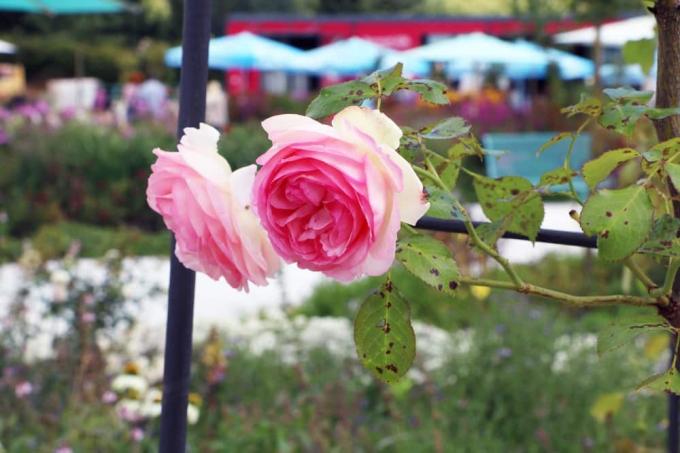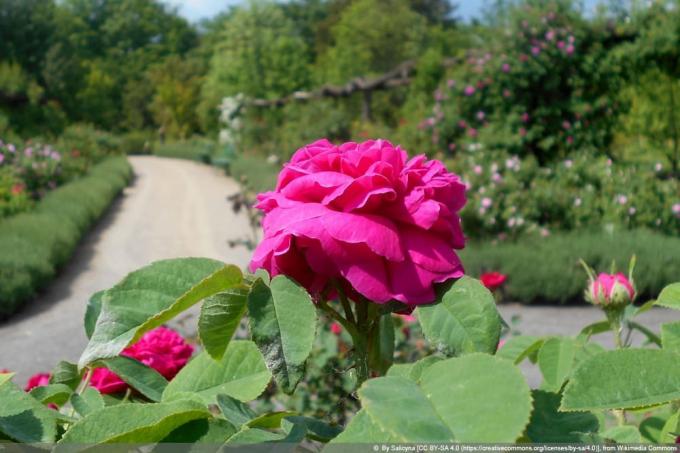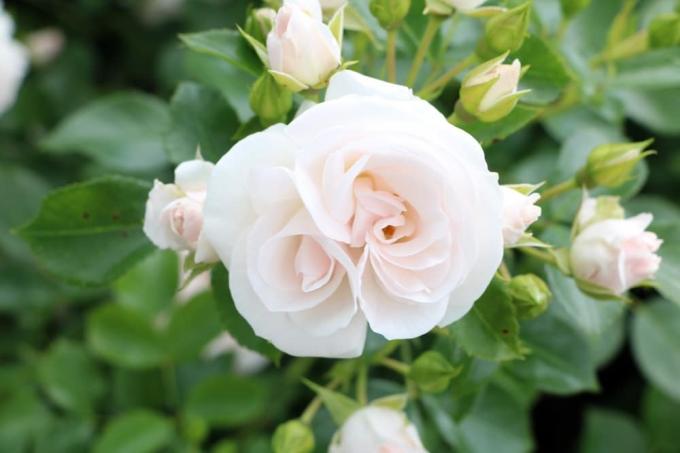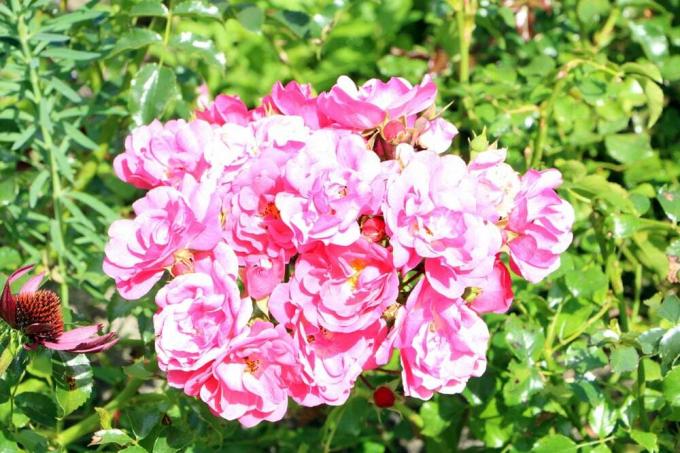

Table of contents
- Damage images, diagnosis
- blackspot
- rose rust
- Wrong mildew
- combat
- First aid
- Accompanying measures
- Chemicals
- prevention
- Location
- soil, fertilize
- tonic
- baking soda
- Garlic
- milk
- Slurry, teas, cold water extracts and broths
- liquid manure
- tea
- cold water extract
- broth
- Fungus resistant rose varieties
- Conclusion
When the beloved rose bush suddenly develops brown leaves, panic breaks out. Is it a dreaded fungal disease? If yes, which? And above all what can I do?
Another scenario: the desire for roses in the garden is great! But how often do you hear that roses are very susceptible to pests and diseases. Should you still dare? – Yes, it is definitely worth it! A lot can be done right from the start to keep the risk of illness as low as possible.
Damage images, diagnosis
Unfortunately, there are several fungal diseases that are noticeable through brown spots on the rose petals. In most cases, there are two fungal diseases that are quite common for roses: blackspot and rose rust. Downy mildew also appears somewhat less frequently, initially with brown spots on the leaves.
blackspot
- Infestation visible from April, May
- Infestation of older leaves at the bottom
- spots of different sizes on the upper side of the leaves
- Spots round, irregularly shaped
- spots black-brown
- Spots radiating out at the edge
- Surroundings of the spots yellow, reddish-orange
- in summer the leaves turn yellow
- leaves fall off
- limited assimilation
- Rose is severely weakened
- hardly any new flowers
- Shoots do not mature
- lower frost hardness
rose rust
- Infestation visible in spring
- Upper sides of leaves show yellowish, rust-red spots
- Spots with dark edges
- Spots become brownish to black
- Spots merge into each other
- Oblong spore bearing underside of leaf
- Spores first yellow then dark brown
- leaves fall off
Wrong mildew
- Infestation visible on the upper side of the leaf
- dark, purple spots
- Spots mostly limited by the leaf veins
- Spots later reddish brown
- Spots brown on the underside of the leaf
- this forms the greyish fungus coating
- stems also show reddish spots
- leaves fall off
- Buds dry up
- meager growth
blackspot
Roses are most commonly attacked by blackspot (Diplocarpon rosae). Black spot disease, also known as black spot, belongs to the sac fungi.
The best living conditions for the blackspot are damp weather, temperatures between 10°C and 15°C and leaf wetness that lasts longer than seven hours.

Until it finds the right conditions, it spends the winter in the ground, in the fallen, diseased leaves, in the shoots and buds. The fruiting bodies cannot be seen with the naked eye. They later form the spores, which only spread when they encounter favorable conditions. They may have to wait several years for this. Even temperatures that are colder than -15°C cannot harm them.
rose rust
Rose rust (Phragmidium mucronatum) does not occur quite as regularly as blackspot. It is a so-called parasitic small fungus and belongs to the order of the rust fungi. For its life cycle, in the course of infection, it goes through five consecutive spore forms. It overwinters in infected leaves or twigs.
This fungus finds the best conditions when the leaves are wet for at least two hours and temperatures are around 20°C. In the spring, the spores are spread by the wind.
Wrong mildew
Peronospora sparsa from the order of egg fungi (Peronosporales) of egg fungi grows in the leaf tissue of its host plants. The spores are transmitted through the air and through splashing water. As a thick-walled, resistant spore, it overwinters in the plant. Downy mildew finds the best conditions in damp, cool weather. That means a relatively high humidity of 15°C to 20°C is optimal.
combat
Anyone who has discovered one of these three fungal diseases on their roses should act quickly. It could already be too late for a purely biological defense. These fungal diseases can only be eradicated completely with fungicides (poisons against fungi). As spores, they are not only invisible, but also so resilient that they defy most biological agents. The measures and recipes presented below can be used for all three fungal diseases.
First aid
- Remove affected leaves and plant parts
- dispose of in the residual waste
- or burn
- Disinfect rose scissors afterwards (with boiling water, alcohol)
- if necessary treat with a fungicide (see chemical agents)
- Strengthen rose (see accompanying measures)
Accompanying measures
With a fungal attack, the rose itself must be strengthened in any case. Similar to sick people, they now need every support to strengthen their immune system.
- Check the soil: the pH should be between 5.5 and 7
- if the soil is too acidic, work in algae flour or rock flour
- Water regularly with ripe nettle liquid manure (very diluted).
- Loosen the soil and clear weeds
- do not fertilize with a high nitrogen content
- Squirting rose with horsetail tea
- otherwise never water from above, always as close to the ground as possible
- Thoroughly clean the soil around the rose before and after hibernation
Tip:
Anyone who is familiar with medicinal plants can collect comfrey leaves and stems and use them to mulch the earth around the rose to strengthen it.
Chemicals

In the case of an existing fungal infection, only chemical combatants can help. You can find out about the individual agents in advance from the Federal Office for Consumer Protection and Food Safety. They keep a database of all plant protection products that are also approved for private gardens.
There are different active ingredients, some of which are harmful to bees and others are not. Most of these agents also destroy other beneficial insects such as parasitic wasps. It is best if they are not used in the first place. In any case, you should be thoroughly informed before use or seek advice from a specialist nursery.
prevention
Preventing fungal diseases is a far more rewarding, albeit labor-intensive, activity. But especially those who enjoy an ecological natural garden with many roses will be successful and above all happier with this type of control.
Location
A very important prerequisite for healthy roses is their location. It should be chosen so that there is good air circulation. This allows the leaves to dry quickly after each downpour. Constantly wet foliage is an invitation for the fungal spores.
A sunny spot is ideal, but not in a sheltered corner. For better ventilation, care should also be taken to ensure sufficient planting distance to other roses or plants. It is best not to plant a new rose in a location where there was a rose before. If this cannot be avoided, the soil must be generously replaced.
Tip:
A good pruning also ensures sufficient ventilation of the rose.
soil, fertilize
The soil should be loamy, humic and permeable, in no case compacted and permanently damp. The roses love a low-acid substrate. Therefore, be careful with nitrogen-rich fertilizers. Fast-growing shoots attract aphids.
In general, too many nutrients tend to weaken the rose. It is best to only fertilize with organic fertilizers or compost.
Tip:
A potassium deficiency can be compensated for by natural fertilization with coffee grounds or rhubarb. (Signs of potassium deficiency: flowers remain small, young leaves are slightly reddish)
tonic
Nature has a lot of material to offer that can be given to roses to prevent fungal diseases. Some of these can prevent further spread even at the beginning of the infestation. Suggestions for biological precautions against fungal infestation:
baking soda
Once budding begins, for a while, every 14 days, spray the roses with a mixture of water and baking soda.
Recipe
- 10 liters of water
- 50 grams of baking soda
Garlic
When the first buds appear, in May, spread the garlic juice on the leaves, and especially on the soil. Best every second or third day. Repeat this at least three times.
Recipe
- 10 liters of water
- 75 grams of garlic
- Roughly chop the cloves and first boil them in a liter of water
- leave for at least 24 hours
- then sieve and dilute
Tip:
Plant garlic cloves in the soil around the roses. They are supposed to enhance the scent and keep the voles away. Whether this also helps against fungal diseases and aphids would have to be tested.
milk
A water-milk mixture should also help against fungal diseases. It can at least stop the infestation, as some professional test series have shown. To do this, prepare a mixture in a ratio of 1:10 (milk: water) and proceed as with "soda".
Slurry, teas, cold water extracts and broths
Spraying and watering with certain plant preparations is an effective preventive measure against fungal diseases. Diluted, they can also be used as fertilizer in irrigation water. Beware of comfrey and nettle, they are high in nitrogen.

Treatment to prevent fungal diseases should be carried out every two weeks from April. Cloudy days with light winds are best, so that the leaves can be shed quickly.
liquid manure
Chop up fresh or dried plant parts in a container with cold water and put them in the sun. Cover airtight and stir daily. Fermentation is to be achieved. Spray fresh liquid manure (bubbles rise) in a ratio of 1:50 with water on the plant. Suitable: nettle, comfrey.
tea
Pour boiling water over chopped plants and let steep for at least 10 minutes. Then use with a 1:10 or 1:20 dilution. For example: garlic, onions.
cold water extract
For a cold water extract, fresh or dried plant parts are soaked in water for a maximum of three days. Fermentation must not occur. The strained liquid can be used undiluted or in a 1:1 ratio with water. Suitable against fungal diseases: horsetail, nettle, comfrey
broth
For a broth, use 1kg of fish or dried plant parts in 10 liters of water. Before that, the material is soaked in a little water for a day, and then boiled for half an hour. After that, cool, strain and dilute with water. This preparation with field horsetail is suitable against fungal diseases.
Tip:
Some tobacco soaked in water for 1-2 days, but without boiling it, should also stop the fungal attack.
Fungus resistant rose varieties
Last but not least, right at the beginning, you can minimize the risk of fungal infections by making sure that you buy rose varieties that are as resistant to fungi as possible. The expertise of an appropriate garden center can be helpful when shopping. The ADR seal also identifies quite reliable and currently particularly robust rose varieties.
ADR stands for "General German Rose Novelty Test". This is an expert committee from the Bund deutscher Baumschulen (BdB) and rose breeders. They also test new rose varieties to see whether they can survive the three-year test period without pesticides and, of course, without diseases.
Some (few) examples of particularly fungus-resistant, robust rose varieties:
- 'heath summer' white, Kordes 1985
- 'snowflake' white, Noack 1991, ADR Rose
- Rosa rugosa 'Alba', white, Asiatic wild rose
- 'Graham Thomas', yellow, David Austin 1983
- 'Felicitas', pink, Kordes 1998, ADR Rose
- 'compass rose', light pink, Noack 1993, ADR rose
- 'The Alexandra Rose', pink-yellow, David Austin 1992
Conclusion
If you don't want to invest so much time in caring for roses, but still not on these magnificent, relatively If you want to do without demanding plants, you should definitely choose the right variety when you go shopping choose. If an infestation with fungal diseases is detected early in the year, the worst can usually be prevented, even without chemical pesticides. From experience it can be said that a light and airy location for the rose is one of the most important prerequisites for protecting it from fungal diseases.
 Home editorial office
Home editorial office
Learn more about types of roses

Pruning wild roses: 6 tips for trimming wild roses
Wild roses should not be missing in any natural garden. They are easy to care for and bloom on two-year-old wood. The delicate blossoms and autumnal rosehips enchant the garden well into winter. To maintain their beauty, however, some maintenance is necessary.

18 historical roses with picture | Varieties of roses for the home garden
Creating a rose garden is not as easy as you might think. The gardener often only becomes aware of the variety of different flower colors on the market when the purchase decision is imminent. So that the selection does not have to be made spontaneously and that it takes into account both the appearance and the location requirements can be optimally adapted to the circumstances of his garden, he will find an overview of 18 historical ones here varieties of roses.

Moss rose (Rosa centifolia var. muscosa): care from A to Z
The moss rose (Rosa centifolia var. Muscosa) is a profusely flowering old rose variety that resulted from a bud mutation. The special thing about her is the green to brownish moss on the buds, sepals and flower stalks and their sweet, slightly resinous scent.

Making roses winter-proof: fleece, bark mulch & Co | Ideal time
Roses depend on good winter protection so that the royal blooms can be repeated next year. The focus is on specific precautions for the crown, trunk and roots, tailored to the respective rose type. This guide gives a practical explanation of when and how to best winterize your roses.

Create a rose bed: easy to care for with roses, perennials and stones
The rose is not considered the queen of flowers for nothing. Her beauty is simply incomparable. It goes without saying that under these conditions it belongs in every garden. Here you can learn how to properly plant a rose bed and properly care for the royal plants.

Tub roses: rose care in the pot | Repot roses properly
In the summer months, the balcony and terrace can be embellished with blooming roses, as these flowers can also be planted in tubs. However, due to the deep roots, there are some important factors to consider when choosing the planter, location, care and repotting.



